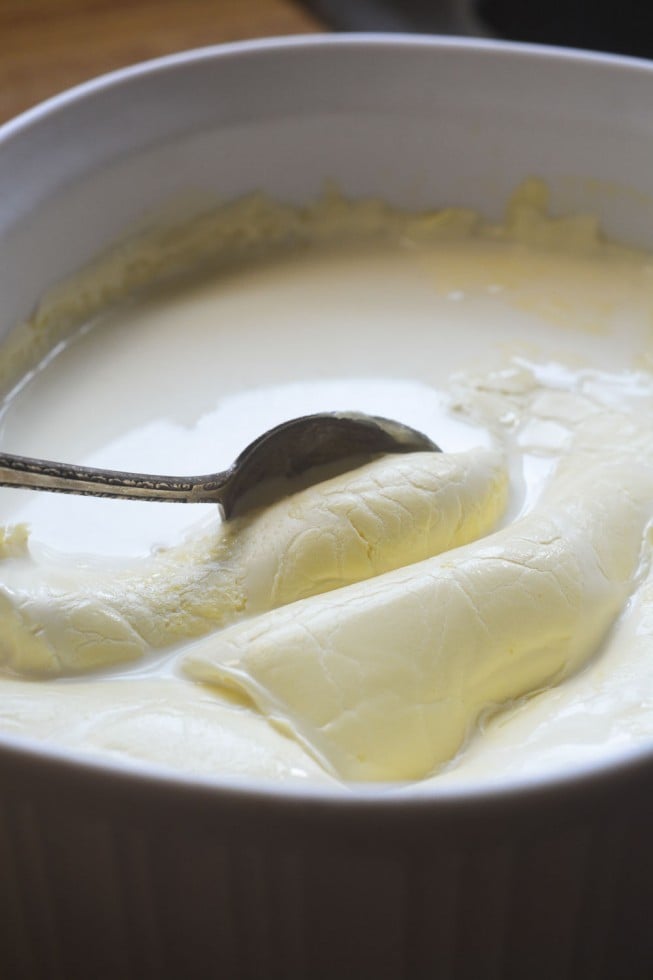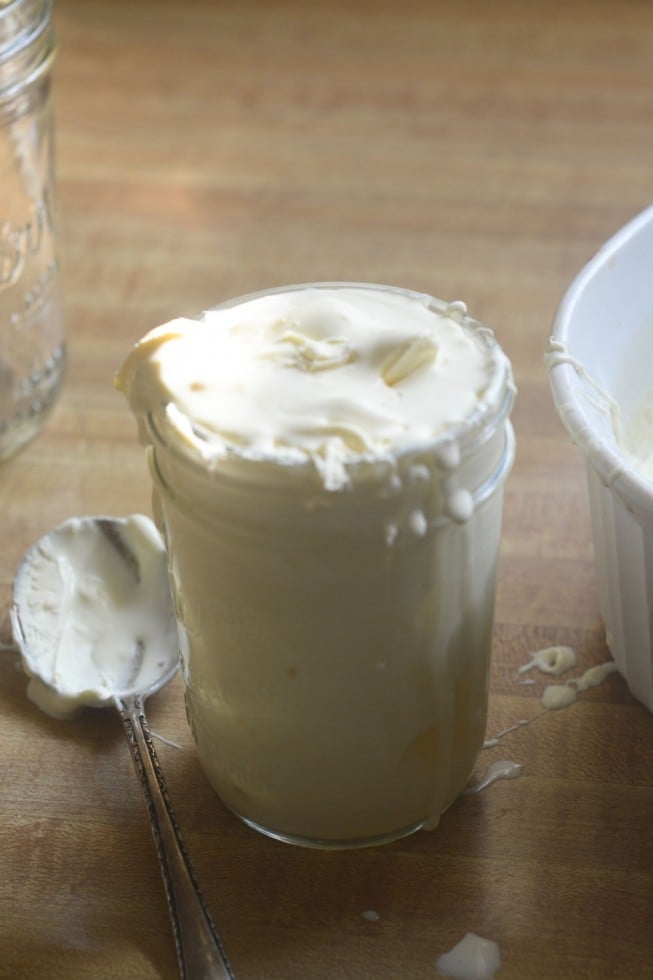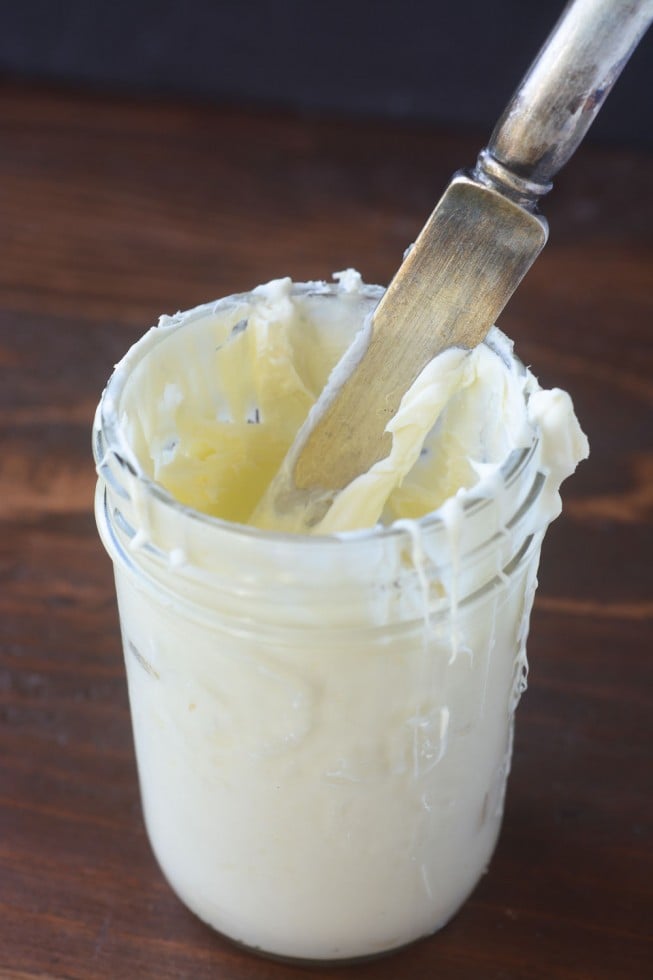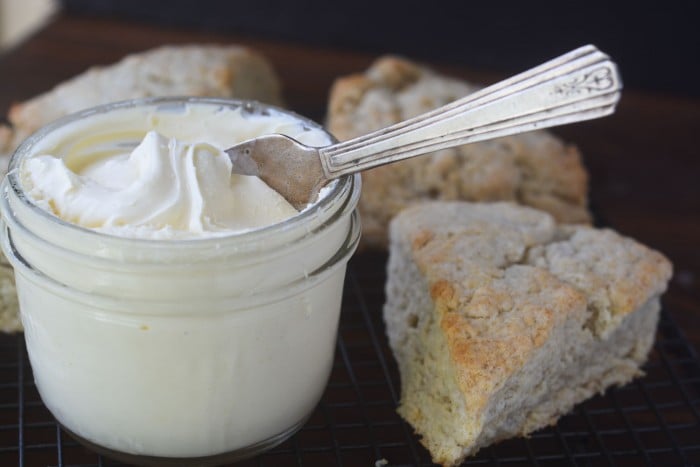“I have a British background and I have always had tea and something sweet. First time I tried this clotted cream I almost ate the entire jar by itself, it is that good!” ~Kim

If you’ve never had a classic English afternoon tea with scones and clotted cream, you’re missing out!
Last week I was treated by the historic Biltmore Hotel in downtown Los Angeles to their classic English afternoon tea. If you’ve never had a classic afternoon tea, you need to experience it. The highlight of any afternoon tea, besides the tea, is the array of tiny treats that comes with it, and I always zero right in on the scones and clotted cream. (That’s them on level two of our 3 tiered tea tray.)

What is Clotted cream?
If you’ve never had it, clotted cream is a very thick rich spreadable form of heavy cream that was first invented ages ago by some very smart British farmers. Traditionally cream heated until it thickens and develops a slightly nutty flavor. Clotted cream has a high fat content (around 55-65%) and a dense texture. It’s not like whipped cream, or cream cheese, it’s not like butter…it has a unique decadent consistency and a wonderful soft flavor. It’s quite thick and spreadable, and when you slather it on a freshly baked scone there is no better thing in the world.
The little pot of clotted cream that we got at the Biltmore had me craving more, and happily I made the most astounding discovery…you can actually make clotted cream at home in your own kitchen. No more tracking it down in specialty stores and paying big bucks for the imported stuff. My homemade clotted cream was actually way better (and a whole lot fresher) than the British stuff I usually buy.

What does clotted cream taste like?
Clotted cream has a rich, creamy taste with a slightly nutty ‘cooked’ flavor. It’s luxurious and indulgent, with a dense, velvety texture that is thicker and creamier than regular whipped cream. Clotted cream is also slightly sweet, but not as sweet as whipped cream or frosting, with a delicate flavor that pairs well with desserts, fruit, and scones. The crust on top of the clotted cream adds a slightly caramelized and nutty flavor, which many people find particularly delicious. The mouthfeel of clotted cream is a key part of its charm, and is like nothing else you’ve ever had!
what you’ll need
- heavy or whipping cream that has not been ultra-pasteurized
- This is cream that has been pasteurized, but not ultra-pasteurized. Ultra-pasteurized cream is cream that has been heated to a higher temperature than regular pasteurized cream to extend its shelf life.

How to make clotted cream
This is an amazing process, I hardly had to do anything, and I end up with a ton of the richest, silkiest clotted cream I’ve ever had.
- I used 2 pints of (non-ultra-pasteurized) heavy cream.
- I poured them into a baking dish, and left it overnight in a 180F oven (the lowest my oven will go.)
- In the morning I let it cool and then refrigerated it for the rest of the day.
- Then I scooped it into jars, which was a little sloppy at first, and put them back in the refrigerator. Any little bit of liquid gets absorbed right into the clotted cream after you put it in the jars, and by the next morning when I had it with my scones, it was absolutely to die for.

How long does clotted cream last?
Homemade clotted cream can last for up to 3-4 days when stored properly in the refrigerator. To extend its shelf life, it’s important to keep it in an airtight container and store it in the coldest part of the refrigerator, such as the back of the bottom shelf.
It’s important to note that clotted cream does not have any preservatives, so it should be consumed as soon as possible for the best flavor and texture. If you notice any changes in color, texture, or odor, discard the clotted cream immediately as it may have spoiled.

What to do with the leftover whey from making clotted cream
The leftover whey from making clotted cream can be used in a variety of ways:
- Adding it to smoothies or protein shakes for a boost of protein and nutrients.
- Using it as a substitute for milk or water in baking recipes such as bread, muffins, and pancakes.
- Using it as a marinade for meat or fish to tenderize and add flavor.
- Adding it to soups or stews for added richness and flavor.
- Using it as a liquid base for making homemade ricotta cheese or other soft cheeses.
- Feeding it to pets, as it is a good source of protein and nutrients for animals.
Note: It’s important to keep in mind that the leftover whey should be used or stored promptly to avoid spoilage. It can be stored in the refrigerator for up to a week or frozen for longer storage.

I can’t say enough good things about this project, the results far exceeded my expectations and it was absurdly easy. The only catch is that you can’t use ultra-pasteurized cream, which is cream that’s been processed for a longer shelf life. Many stores only sell ultra-pasteurized cream, so you have to search a bit for regular cream. I found mine at Whole Foods. Just read the labels… if it doesn’t say ultra-pasteurized on the label, you’re good to go.
can you make clotted cream with ultra-pasteurized cream?
Some readers in the comments below have had success with ultra-pasteurized cream. It is possible to make clotted cream from ultra-pasteurized cream, but it may be more difficult to achieve the desired texture and flavor. Ultra-pasteurization is a process that heats the cream to a higher temperature than regular pasteurization, which extends its shelf life but can also alter the proteins and enzymes in the cream. This can make it more difficult for the cream to form clots, which are necessary for making clotted cream.

What to eat with your homemade clotted cream
You will definitely want to make scones to go with your homemade clotted cream. I have lots of recipes for scones on the blog, but a simple one to start with is my Classic Cream Scones Recipe.

Tips for making clotted cream
- Make sure your cream is not ‘ultra pasteurized’, you will need to find regular pasteurized cream at a Whole Foods or other similar store. Ultra pasteurized cream has been treated in a way that prevents it from ‘clotting’.
- An oven thermometer is an essential kitchen tool, and really comes in handy for this project. If your oven is too cool or too hot your homemade clotted cream will not ‘clot’. Set your oven to 180F and then check the thermometer. You can adjust up or down as necessary.
- If your oven does not go down as low as 180F you can try one of my other methods for making clotted cream:

Homemade Clotted Cream
Video
Equipment
- a heavy casserole dish
Ingredients
- 2 pints heavy cream or whipping cream (double cream in the UK), avoid ultra-pasteurized cream for best results.
Instructions
- set your oven to 180F
- Pour the cream into the casserole dish. It should come up about 1-3 inches on the side.
- Set the dish, uncovered, in the oven and leave undisturbed for 12 hours. Be sure to leave the oven on the whole time. I do this overnight.
- Remove the dish from the oven and set to cool. Then cover and refrigerate. Note: the cream may seem thin at this point, but is going to thicken considerably overnight.
- The next morning scoop the thickened cream into a jar or jars, and cover and put back in the refrigerator. You can use the leftover cream for baking..
- Spread the clotted cream on freshly baked scones.
Nutrition























Just pulled mine out of the oven after 12 hours at 180 degrees. And, apparently, my oven turns off on its own after twelve hours. It looks a bit weird with a pale yellow-ish crust on top and watery area underneath. It’s cooling now, and then will go into the fridge. Fingers crossed this works out as I love clotted cream and have a scone recipe at the ready.
Mine looked super weird when I took it out of the oven, yours sounds just right — fingers crossed!
Thanks, I feel much better now. I am SO EXCITED!!
If it has a pale yellow crust you’re doing it right! Clotted cream originates in Cornwall (where I’m from) and it’s always served with the crust on.
Thank you Sarah!
I can’t eat dairy anymore, but my husband dreams of scones with clotted cream and jam and it’s always near the top of the list of things to eat when we go home to Scotland! I had NO idea you could make this, we’ve tried the stuff they sell here but it’s not the real deal, this will be on his menu very soon!
You should make it for him for Valentine’s Day!
Oh, how I love having tea and all the sandwiches and desserts to go with it. I was thrilled to finally have tea and the Grand Empress in Victoria and I have wanted to make clotted cream ever since. Just last week, I found a video that shows the same process that you do. I just couldnt’ find the heavy cream. (Slaps forehead.) Whole Foods! Of course. Everything looks lovely, and I have a scone recipe I’m anxious to try– though the vanilla and cardamon sounds fantastic.
Wouldn’t it be fun to travel around going to various high teas? Good luck with your clotted cream Debby!
Alton Brown’s version is pretty easy & doesn’t require the oven be on overnight (or at all). Just strain it through coffee filters.
http://www.foodnetwork.com/recipes/alton-brown/clotted-cream-recipe2.html
That does sounds easy, but part of the distinctive flavor of clotted cream, I think, comes from it being ‘cooked’ slowly. And I can’t imagine that the texture could be as thick as mine if it’s just strained. I’ll definitely have to give it a try to see!
Sue is right , Alton’s version is simply thickened cream. British style clotted cream that I’m used to is thick, almost spreadable, and has a slightly tangy almost sour (but not off) taste.
Mmmm….craving this right now! I got to do high tea at the Fairmont Empress in Victoria BC and that was so much fun. What a great treat!
Oooooh!!! I LOVE clotted cream! I’ve never been able to find it anywhere outside of Britain and it’s definitely on my top five favorite foods list. Thank you thank you thank you!
Just one question: how long do you think this would last in the refrigerator, and how much cream does it make? Is it the same quantity or does it reduce somewhat?
It will probably vary slightly with everyone, but I’m going to say it’ll last at least two weeks tightly covered in the fridge, and this recipe makes about 2 cups of clotted cream, which is a lot because a little goes a long way!
Hi Jess, I’ve made clotted cream lots of time using this fab recipe and once it’s been cooled you can actually freeze it successfully. I’ve made larger batches, put it into plastic pots when cold and frozen for up to 3 months, so you can enjoy it anytime. Just thaw in fridge overnight and it’s perfect! ?
I do afternoon tea frequently and love hearing about other people enjoying it as well! A friend I introduced to afternoon tea about 20 years ago absolutely adores clotted cream, and it’s been far too long since I’ve made it. She will thank you for inspiring me!
The Biltmore is such a fabulous place to have tea and your scones + cream look like a dream!
The Biltmore looks fabulous. The Brown Palace in Denver also does high tea and it is fun. Though their decor is not quite as glorious. Love clotted cream and you know I love scones. Yours, in particular!
The photos show the Biltmore doing one thing un-British however. When I was in England, they explained to me that you always start to eat from the bottom tier upwards during tea. Therefore, you place the tea sandwiches on the bottom tier, the scones (pronounced “Scunns” and does NOT rhyme with bones-as they corrected me;) on the middle tier and sweets/desserts that you finish last with on the top tier.
Tea originated in China so tea lovers or tearooms that offer tea should present it in any way they desire…’un-British’ or not. Scones is pronounced differently depending on regions so there is no right/wrong. And for anyone afraid to host a tea event because of so-called rules, I say throw ‘em out the window and start your own tea rituals/traditions. Just have fun…it’s all about treating your guests and yourself special. Trust me, no one will care/remember what tiers all the yummy treats are on! 🙂
Clotted cream is such wonderful stuff, isn’t it? And it’s easy to make! I haven’t made any in years, though — but now you have me craving it. Really good post — thanks.